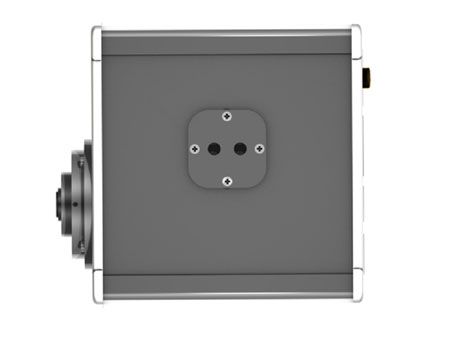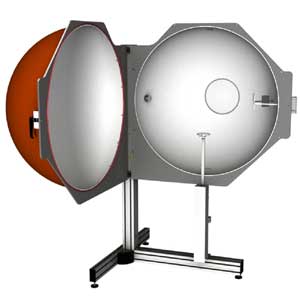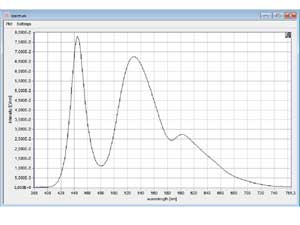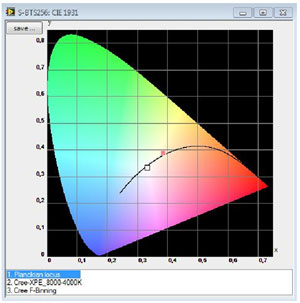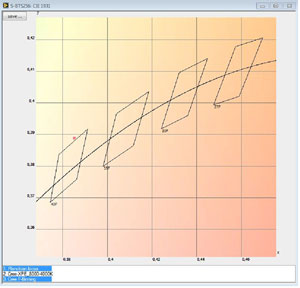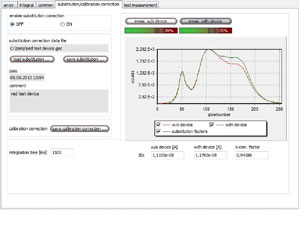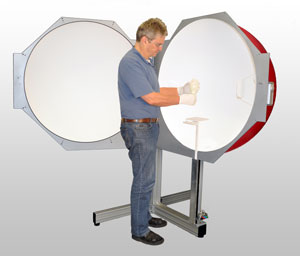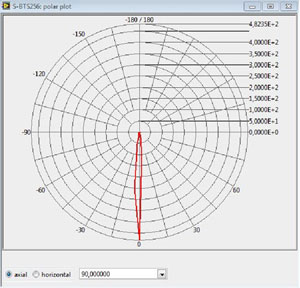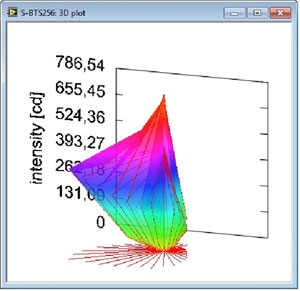BTS2048-VL BiTec Sensor Spectroradiometer
High-Quality Photometric, Radiometric, Spectral-Radiometric and Colorimetric Measurements
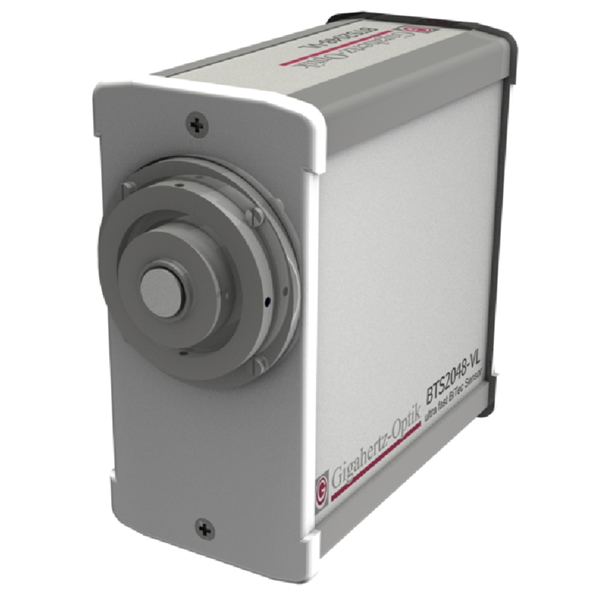
The BTS2048-VL is a fast response high-quality light meter for photometric, radiometric, spectral radiometric and colorimetric measurements.
Its compact design and innovative optical, electronic and mechanical interfaces make it ideal for integration into high-end industrial, medical and scientific measurement applications.
BiTec Light Sensor for More Accurate Light Measurement
One of the most key features of the BTS2048-VL is its BiTec light sensor. The BTS combines a silicon photodiode with a CCD diode array. Through bilateral correction of measurement signals from both sensors, the BiTec sensor ensures extremely precise photometric and spectral-radiometric measurement values over a large dynamic range.
High-Quality Back-Thinned CMOS Detector
The 2048 pixel diode array has a useable spectral response from 280 and 1050nm with a 2nm optical bandwidth and a pixel resolution of 0.4nm/pixel. Due to the back-thinned technology this CCD chip is significantly more sensitive than a conventional front-illuminated CCD chip.
Flash Spectroradiometer for LED Binning
Another key feature is an electronic shutter built into the detector assembly. This allows for the measurement of pulsed light. Together with the diverse trigger functions available, integration times of between 2μs and 4000ms and the extremely fast micro-processor, the BTS2048-VL is well suited for LED binning applications as well as for measurement of flashing beacons, strobes, burst LEDs and other pulsed light sources.
Precise Spectroradiometry
To facilitate the optimum use of the CCD sensor's dynamic range the BTS2048-VL includes a remote controlled filter wheel is placed in the optical beam path. enables amplification of the dynamic range of the CCD sensor to additionally ensure precise measurement of light sources having varying intensities.
Diffuser Window Replaces Light Guide
As for the input optics, the BTS2048-VL has an incorporated diffuser window with a cosine corrected field of view. The fact that a light guide has not been used to this effect makes room for improved photosensitivity and reduced measurement uncertainty. The f2 adjustment of the cosine corrected field of view to less than 3% makes it possible to use the BTS2048-VL for direct light measurement in absolute photometric, colorimetric and radiometric measurands as well.
- Illuminance (lx)
- Luminous intensity (cd)
- Color temperature
- Color Rendering Index
- Color coordinates
- Irradiance (W/m2)
- Spectral irradiance (W/m2 nm)
- Radiant intensity (W/sr)
- Spectral radiant intensity (W/sr nm)
Luminous Flux Measurement
When mounted to and calibrated with Gigahertz-Optik integrating spheres the BTS2048-VL provides fast accurate measurement of luminous flux, spectral radiant flux and luminous color. Its fixed diffuser window can be positioned in the sphere such that an uninterrupted hemispherical field of view is created one of the essential criteria of CIE LM79.
Gigahertz-Optik manufactures a wide range of integrating spheres, associated integrating sphere components, integrating sphere detectors and calibration standards.
Luminous Intensity Distribution Measurement
Goniometers or goniophotometers are used to measure the luminous intensity distribution of lamps, luminaires and other light sources. Using the BTS2048-VL photometer in goniometric systems will significantly reduce the measurement time:
- Fast, photometric matched photodiode for short measurement times over a large dynamic range. Photodiode with active correction of the spectral mismatch through spectral measurement values
- Fast, spectral measurements through the optimized optics and the high-quality diode array
- Synchronized measurements through the diode array with electronic aperture and trigger functions
- Ethernet and USB2.0 interfaces for fast data exchange (30ms for 2048 float values via ethernet)
Ultra-Fast Interfaces
The BTS2048-VL is controlled via USB2.0, ethernet, RS232 or RS485 interface. With regards to the communication speed, ethernet port is superior to the USB2.0 interface. Furthermore, the amount of data to be sent is thereby limited so that data preparation occurs in the BTS2048-VL. For this purpose, an independent, high-performance microprocessor is incorporated.
User Software with Flexible Desktop Structure
S-BTS2048 user software is supplied with the BTS2048-VL. A user friendly feature is a flexible desktop that can be individually configured with selectable graphical and numerical display windows:
- Freely definable numerical displays in decimal or scientific representation. Zoom function.
- Numerical display fields for radiometric, photometric, colorimetric, Ra to R15 color rendering index, spectral and other measurands.
- Measurement protocol of the selected measurement parameters.
- CIE 1931 chromaticity diagram. Zoom function.
- CIE 1976 chromaticity diagram. Zoom function.
- Spectrum. Zoom function.
- Data logger. Zoom function.
- etc.
Traceable Calibration
Calibration of the BTS2048-VL, including any accessories, is performed by Gigahertz-Optik optical radiation calibration laboratory with reference to national and international calibration standards.
Optional BTS2048-VL Accessory Components
Integrating Spheres
The utility of the BTS2048-VL can be extended using integrating spheres for luminous flux and spectral radiant power measurement.
Gigahertz-Optik manufactures a wide range of integrating spheres in different sizes, coatings and configurations. Spheres for luminous flux measurements are equipped with auxiliary lamps to compensate for the self-absorption effect of the test object on the responsivity of the measurement device.
LM79 Conformal Integrating Sphere / Luminous Flux Meter
In conjunction with Gigahertz-Optik's one meter diameter integrating spheres, the BTS2048-VL meets the requirements of LM79 for luminous flux photometers and sphere spectrometers.
Traceable Calibration
The Gigahertz-Optik optical radiation calibration laboratory offers calibration reference standard lamps for recalibration of the spectral photometer for luminous flux, luminous color and spectral radiant flux. Recalibration is supported by the S-BTS2048 user software.
Goniometer Photometer
Gigahertz-Optik manufactures goniometers for use with the BTS2048-VL. Goniophotometers measure the angular distribution of both directional and omnidirectional radiating light sources and can also measure total luminous power.
Control Software
S-BTS2048 user software supports control of the goniophotometer and data reading and storage & export from the BTS2048-VL. The user can set-up the measurement sequence for symmetric or individual measurement procedures. Measurement values showing the radiation characteristics are displayed both numerically and graphically. Readings can be converted to ASCI, excel, IES and EULUMDAT data formats and saved. Besides luminous intensity distribution entire or effective luminous flux is also calculated.
To Order The BTS2048-VL BiTec Spectroradiometer, Call Us Today At 1-978-462-1818.
Specifications
| BTS2048-VL: | Lightmeter with spectroradiometer and photometer function. Parallel measurement with diode and array, linearity correction of the array hrough the diode. Online correction of the spectral mismatch of the diode through a(Z) and/or F*. |
||||||||||||
| Measurands: | Spectral irradiance (W/(m² nm)), illuminance (lx), dominant wavelength, peak wave length, centre wavelength, centroid wavelength, x, y, u´, v´, X,Y,Z, delta uv, color temperature, color rendering index (CRI) Ra, R1-R15, Option integrating sphere: in addition spectral flux (W/nm) and luminous flux (lm) Option goniometer: in addition radiant intensity and luminous intensity distribution | ||||||||||||
| Spectroradiometer: | Check spectral detectors specifications | ||||||||||||
| Photometer: | Accuracy class B according to DIN 5032 and CIE No. 69 Accuracy class A for f1`, u, f3 and f4 according to DIN 5032 and CIE No. 69 |
||||||||||||
| Input optics: | Input diffuser with cosine corrected field of view (f2 < 3 %) | ||||||||||||
| Filter wheel: | 4 positions (open, closed, OD1, OD2). Use for remote dark current measurement and dynamic range extension. | ||||||||||||
| BiTec light detector: | Parallel measurement with diode and array, linearity correction of the array through the diode. Online correction of the spectral mismatch of the diode through a(Z) and/or F*. | ||||||||||||
| Processors: | 32bit for device control,16bit for CCD array control, 8bit for photodiode control | ||||||||||||
| Interfaces: | USB V2.0, Ethernet (LAN UDP protocol), RS232, RS485 | ||||||||||||
| Data transfer: | Standard for 2048 float array values via ethernet 30ms, via USB 140ms | ||||||||||||
| Input Interfaces: | 2x (0 - 25) VDC, 1x optocoupler isolated 5 V / 5 mA | ||||||||||||
| Output Interfaces: | 2x open collector, max. 25 V, max. 500 mA | ||||||||||||
| Triggering: | Trigger input incorporated (different options, rising/falling edge, delayed, etc.) | ||||||||||||
| Spectral Detector: | |||||||||||||
| Spectral range: | (280 -1050) nm | ||||||||||||
| Optical bandwidth: | 2 nm | ||||||||||||
| Pixel resolution: | 0,4 nm/pixel | ||||||||||||
| Number of pixels: | 2048 | ||||||||||||
| Array-Type: | Highly sensitive back-thinned CCD chip | ||||||||||||
| ADC: | 16bit (25 ns instruction cycle time) | ||||||||||||
| Integration time: | 2 - 500) μs*1 (0,5 - 4000) ms*2 |
||||||||||||
| Peak wavelength: | ±0,2 nm | ||||||||||||
| Dominant wavelength: | ±0,5 nm | ||||||||||||
| Δx and Δy: | ±0,0020 (Standard illuminant A) ±0,0025 (common LED) |
||||||||||||
| Repeatability Δx and Δy: | ±0,0001 | ||||||||||||
| ΔCCT: | Standard illuminant A 50K; LED up to +/- 4% depending of the LED spectrum | ||||||||||||
| Band-pass correction: | mathematical online band-pass correction is supported | ||||||||||||
| Linearity: | completely linearized chip >99.6% | ||||||||||||
| Scattered light: | 2E-4*3 | ||||||||||||
| Base line noise: | 5 cts*4 | ||||||||||||
| S/N: | 5000*5 | ||||||||||||
| Dynamic range: | >9 decades | ||||||||||||
| Responsivity range spectral irradiance: | (1E-5 - 1E5) W/(m²nm) *6*7 | ||||||||||||
| Calibration: | Spectral irradiance
|
||||||||||||
| Photometric detector: | |||||||||||||
| Integration time: | (0,1 - 6000) ms | ||||||||||||
| Measurement range: | seven (7) measurement ranges with transcendent offset correction | ||||||||||||
| ADC: | 16bit (25 ns instruction cycle time) | ||||||||||||
| Spectral responsivity: | Spectral responsivity with fine CIE photometric standard matching. On-line improvement of the photometric matching by the measured spectral data of the light source. | ||||||||||||
| Measurement range illuminance: | Max measureable illuminance value 3E8lx*7 Noise equivalent illuminance value 1E-1lx |
||||||||||||
| Calibration: | Illuminance +/- 2,2 % | ||||||||||||
| General specification: | |||||||||||||
| Software: | User software S-BTS2048 Optional software development kit S-SDK-BTS2048 for user software set-ups based on .dll's in C, C++,C# or in LabView. |
||||||||||||
| Power supply: | With poser supply: DC Input 5V (±10 %) at 700 mA With USB bus (500mA)*8 |
||||||||||||
| Dimensions: | 103 mm x 107 mm x 52 mm (Length x Width x Height) | ||||||||||||
| Weight: | 500g | ||||||||||||
| Mount: | Tripod and M6 screw threads Front adapter UMPA-1.0-HL for use with integrating sphere port-frame UMPF-1.0-HL |
||||||||||||
| Temperature range: | Storage: (-10 - 50)°C, Operation: (10 - 30)°C |
| *1 | no linear dark current i.e. dark measurement is required for each integration time. |
| *2 | linear dark current i.e. dark current measurement can be scaled with the integration time in this range.
It is however recommended to perform a new dark measurement for each integration time. |
| *3 | typical value measured 100nm left of the peak of a coldwhite broadband LED. |
| *4 *5 |
typical value measured without averaging in a measurement time of 4ms and full scale of the array.
By averaging, the S/N rises das Basisrauschen quadratisch, z.B. 100Fache Mittelung verbessert um Faktor 10. |
| *6 | Min value at s/n of 1/500. Max value at full level control. |
| *7 | Irradiation time limited in case of high temperature radiation to avoid thermal damaging of the device. |
| *8 | If connection is via USB, not all device functions are supported due to the limited power. For instance no Ethernet. |
